Sales Forecasting Methods
- 1. Intuitive Forecasting
- 2. Opportunity Stage Forecasting
- 3. Length of Sales Cycle Forecasting
- 4. Historical Forecasting
- 5. Multivariable Analysis Forecasting
- 6. Pipeline Forecasting
Making smarter decisions when setting goals, budgeting, prospecting, and hiring is possible when you are able to forecast sales accurately. Sales forecasting can play an important part in the success of your business.
To benefit from forecasting, you need to know how to create realistic reports. We've gathered some great sales forecasting methods and templates to help guide you.
What Is Sales Forecasting?
Sales forecasting is the process a business carries out to estimate what their sales will be in the future. Sales forecasting periods can be quarterly, half-annually, annually, or monthly.
Sales forecasting allows you to notice key indicators that tell you how your business is performing. This information lets you plan ahead by giving you a good idea of the amount of revenue you expect within a specific time period.
Your sales projections also let you know what things you need to focus on in your sales strategies, such as lead generation or sales acceleration. You can use the information gathered from sales forecasting to make important financial decisions for your business, like whether or not to get a small business loan or to expand.
Essentially, it helps you spot potential issues while there is still time to mitigate or avoid them. For instance, if you notice your sales team has only been hitting their goals 40 percent of the time, you can determine the root cause and then correct the issue.
Remember that your sales forecasts are estimates, and they don’t need to be perfect to be valuable to your company. But you should also factor in the things that may impact your sales forecast.
8 Factors That Impact Your Sales Forecast
Take note of these eight factors that can happen internally and externally to impact your sales forecast.
Hiring and Firing Salespeople
Your sales are likely to decrease when one or more of your salespeople exits your company, unless you have potential new hires already lined up. Your sales are also affected when you hire a significant amount of sales reps at one time.
Once they’ve been trained and are fully equipped to sell, then you can predict a jump in your business sales.
Economic Conditions
Buyers are more likely to invest their money into the service or product you are offering when the economy is doing well.
If there is an economic downturn, the sales cycle may take longer than expected, and there will be more scrutiny involved with each purchase a lead considers.
This means you must remain aware of the current economic condition every time you forecast sales.
Market Changes
Analyze data and trends among your customers to account for market changes. For example, if you sell consulting services to the hospitality industry, then you’d want to know if a rise in tourism was anticipated for the near future.
Policy Changes
You must adjust your sales forecast based on new policies that are implemented, especially if they directly affect your sales team.
For instance, say you make a new policy for your sales development reps that only allows them to offer a discount until the 15th of each month. You are likely to see an increase in closed deals at the beginning of the month, then you may see fewer sales than normal at the end of the month.
Product Changes
Any changes to your products are likely to affect sales. If you unveil highly anticipated features on your products or introduce a new pricing modal, your salespeople may be able to increase the size of the deals they close.
The changes you make to your products allow your salespeople to win more business and possibly shorten their sales cycle.
Seasonality
Your business might appeal more to your customers at specific times during the year. Some of your customers may assess purchase in one season and then purchase in another season. Pay attention to these trends and include them in your forecast.
Legislative Changes
When new laws and mandates are introduced, they may positively or negatively impact your business. They may create demand for your product or service, or they may cause people to become hesitant when they consider purchasing your solution.
Competitive Changes
What your competitors do can impact your closing rates. For instance, if one of the competitors in your industry dramatically cuts their prices, you may need to offer more discounts to help your sales reps close deals.
On the positive side, if one of your competitor goes out of business, you may see increased demand.
6 Sales Forecasting Methods and Examples
There are several ways to forecast sales for your business. The method you choose depends on your business needs and objectives.
Here are a few common methods used for sales forecasting:
Intuitive Forecasting
Intuitive forecasting is based on the estimated likelihood that sales reps have of closing deals. This form of sales forecasting relies on the opinions and projections of your sales team members.
For instance, a salesperson might report that they are confident that a lead will close within 14 days and the deal will be worth X amount.
Although this forecasting method relies on the ones closest to your prospects, reps tend to be optimistic and may offer estimates that are overly generous.
This method is difficult to scale, but it can provide value to new companies when there is no historical data available for them to use for forecasting.
Example
Pretend that you have no historical data and you would like to forecast sales for your brand new business. The business has only been operating for about three months, and you have two or three salespeople on your team.
You ask them to make well-informed predictions about the deals in their pipeline and prospecting opportunities. They forecast the sales based on their intuition, and they let you know that they forecast $30,000 in sales for the next three months.
Opportunity Stage Forecasting
The opportunity stage method takes into account the stages of the sales process. The way it works is you make predictions based on the stage each deal is in. The idea is that the further along in the pipeline a deal is, the likelier it is to close.
After you select a reporting period, you multiply each deal’s possible value by the probability of it closing.
You then add up the total for each deal in the pipeline to get your average overall sales forecast.
This method is easy to calculate, but you also have to trust that your salespeople are clearing out their pipeline regularly to rid it of old or stale leads. If not, it leads to inaccuracies due to the failure to consider the age of an opportunity.
Example
Let’s say you have determined which stages of the pipeline are likely to close based on the following percentages:
- First call: 5 percent
- Lead Qualified: 15 percent
- Demo: 30 percent
- Product Trial: 55 percent
- Final Contact: 85 percent
- Deal Closed: 100 percent
Let’s say with this model, a $2,000 deal at the demo stage is 30 percent likely to close. The forecasted amount for this would be $600.
Length of Sales Cycle Forecasting
This method uses the age of each opportunity in the pipeline to predict when they may close.
The sales forecasting method relies on objective data instead of feedback from the sales reps, which means this method is less likely to result in predictions that are too generous.
This technique applies to different sales cycles. For instance, a regular lead may take six months to close, but a referral only takes one month, and leads from events may take eight months to close.
You can categorize your deal type by the length of the sales cycle with this method.
Example
If your average sales cycle lasts about four months and your salesperson has worked on this account for two months, your forecast is likely to suggest that they are 50 percent likely to close the deal.
Historical Forecasting
Historical forecasting is all about predicting your future sales based on your past sales in the prior years or time periods. Basically you assume that your sales amount will be greater than or equal to past amounts.
This method assumes that buyer demand is constant, and it doesn’t take seasonality into consideration.
Typically, historical demand should be used as a benchmark rather than as a foundation to forecast your sales.
Example
Let’s say you and your team achieved $100,000 in sales in monthly recurring revenue in April. According to this method, you can assume that they will sell $100,000 or more in May.
This prediction can be enhanced by adding the figure from historical growth. If your team increases sales by five percent each month, a good estimate for May would be $105,000.
Multivariable Analysis Forecasting
This is a comprehensive and accurate sales forecasting method. It uses predictive analysis and incorporates various factors mentioned earlier in this article. For instance, it accounts for individual rep performance, length of sales cycle, and probability of closing according to opportunity type.
Your reps must be dedicated to tracking their deal activities and process for you to gain accurate results when using this method.
Example
Let’s say you have two sales representatives working on two separate accounts. One rep has a meeting to close a deal scheduled for Monday, and your second rep finished the first presentation to a new lead.
Based on their closing rate at their respective stages, added to the predicted deal size and how much time is left in the quarter, your first rep is 60 percent likely to have a win for this period. Your forecast is $6,900.
Your second rep is also 60 percent likely to close even though the deal is smaller, which gives you a forecast of $4,000.
Combine both figures, and your sales forecast for the quarter is $10,900.
Pipeline Forecasting
The pipeline forecasting method can be quite time consuming if you don’t have a system in place to assist you with your calculations.
This method reviews each lead in your pipeline and determines the chances they have of closing. The calculations are based on things like opportunity value and a sales reps closing rate, along with other distinct company variables.
The success of this method relies on your organization’s ability to produce and keep track of useful data.
Pipeline Forecasting Tools
This forecasting method requires a sales forecasting tool because pipeline forecasting is often complex. It takes into account specific factors for each opportunity in your pipeline.
You have to use the data in your CRM or sales software and plug it into a forecasting tool to find out what your monthly or quarterly forecast is. Use tools like Jirav or DealCloud to help you figure out your forecasting figures for this method.
5 of the Best Sales Forecasting Templates
Sales forecasting templates can help you organize your data effectively to present you with accurate figures for your projected sales growth. Here are five great sales templates for you to consider:
3-Year Sales Forecast Template
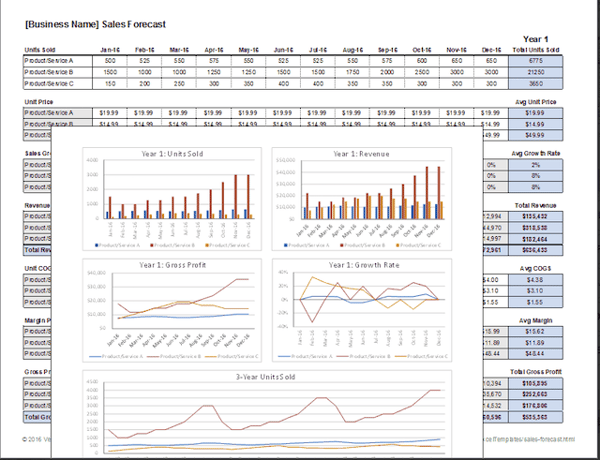
The three-year sales forecast template helps you to plan ahead to forecast sales long term. It is a good template for businesses and startups that would like to obtain funding from investors or banks.
This template can be added to your sales plan to show investors and banks what revenue your business will bring in long term.
You can use this template with Excel to plug in your numbers and data. The formulas calculate and graph your results automatically.
Deal-Based Sales Forecast Template
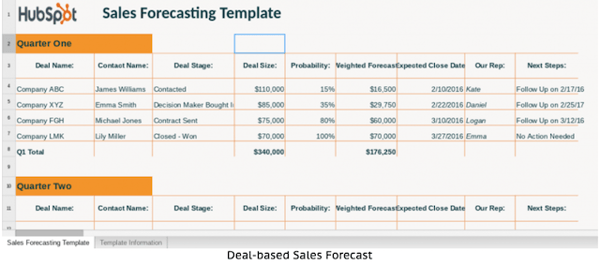
A deal-based sales template allows you to forecast your sales quarterly. It focuses on sales deals, and it divides your sales by sales rep, dollar amount, company, opportunity, and the probability a deal will close.
This template is good for B2B businesses who want to manage sales based on each opportunity as they progress through the sales pipeline.
The template is free to download through HubSpot.
Budget Sales Forecast Template
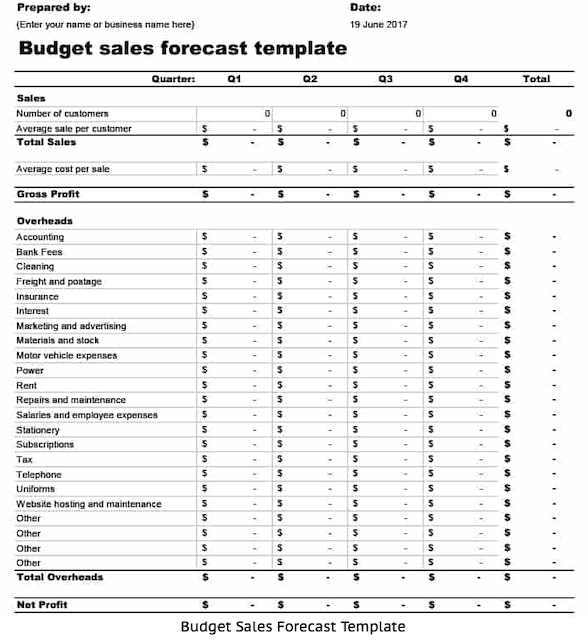
This budget forecast template allows you to forecast sales quarterly. It is a great template for those who run small businesses since it helps them get an idea of their sales forecast and budget.
This template is effective because it helps you to view your sales and budget from quarter to quarter so you can see how your sales revenue will help you pay for your expenses.
Your template can be downloaded from Template Archive.
B2B Lead-Driven Sales Forecast Template
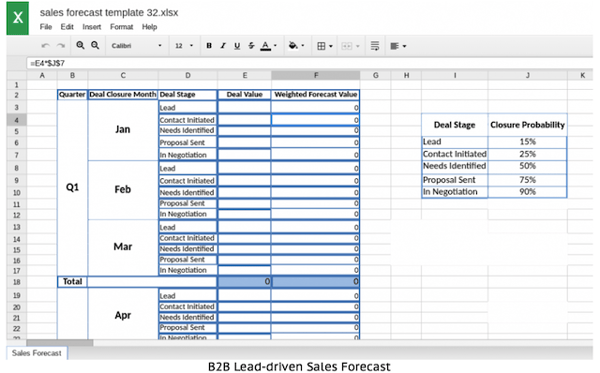
This template is quarterly and is based on leads, what stage they are in, and the likelihood that they will close. It is great for businesses that forecast sales each quarter and for B2B sales.
The template exists in Excel and can be downloaded for free from Close.
Cash Flow-Based Sales Forecast Template
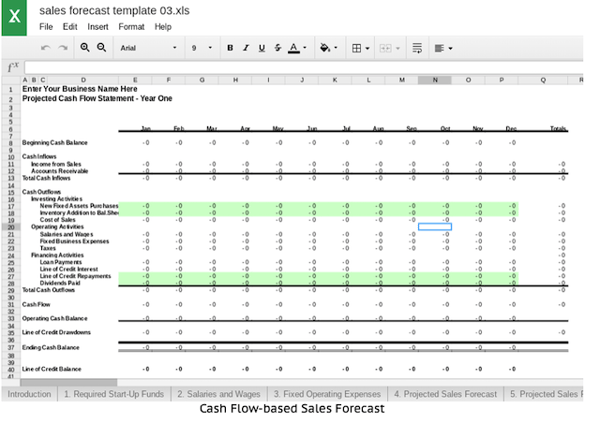
The cash flow-based sales forecast template is useful for you if you want to view your sales impact each month. It is also good for you if you want to assess your projected sales right away to help you focus on cash flow.
The template is downloadable in Excel.
Building trustworthy sales forecasts can help you prepare for the future. There are plenty of sales forecasting methods out there that require intuition, complex algorithms, and historical analysis.
Having the right method for your business could be critical to helping you run your business and manage your sales team. Consider the methods wisely and start forecasting sales today!

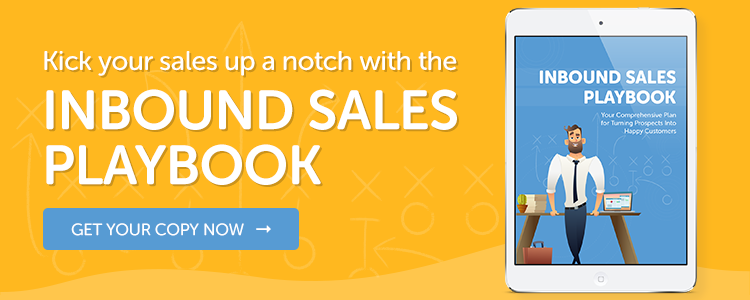
Erika Giles
Erika is a Marketing Copywriter at Bluleadz. She is a huge fan of houseplants and podcasts about conspiracy theories. She spends most of her free time reading, writing, and enjoying the outdoors.